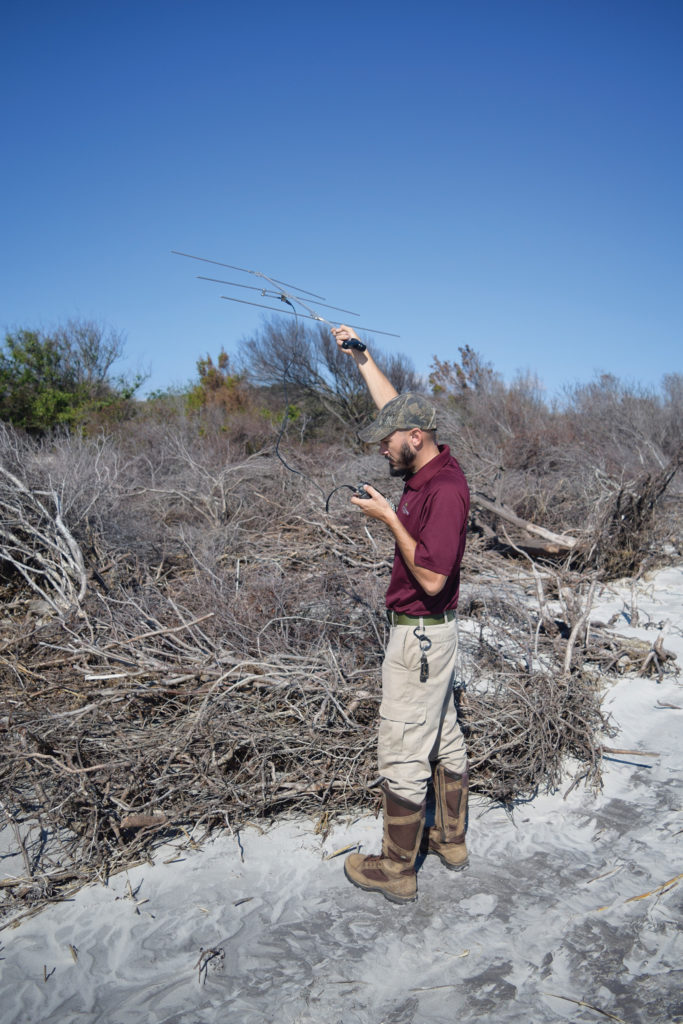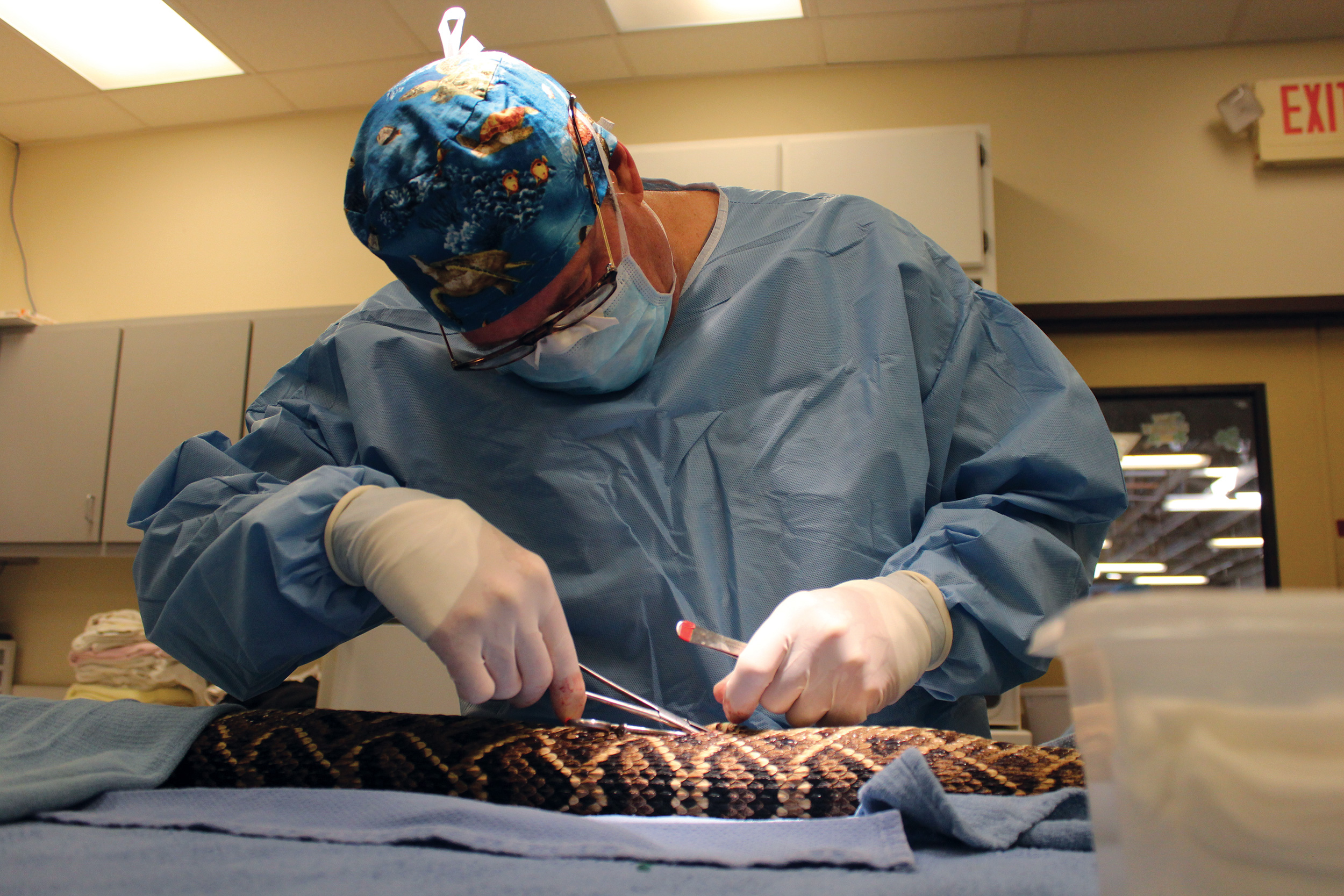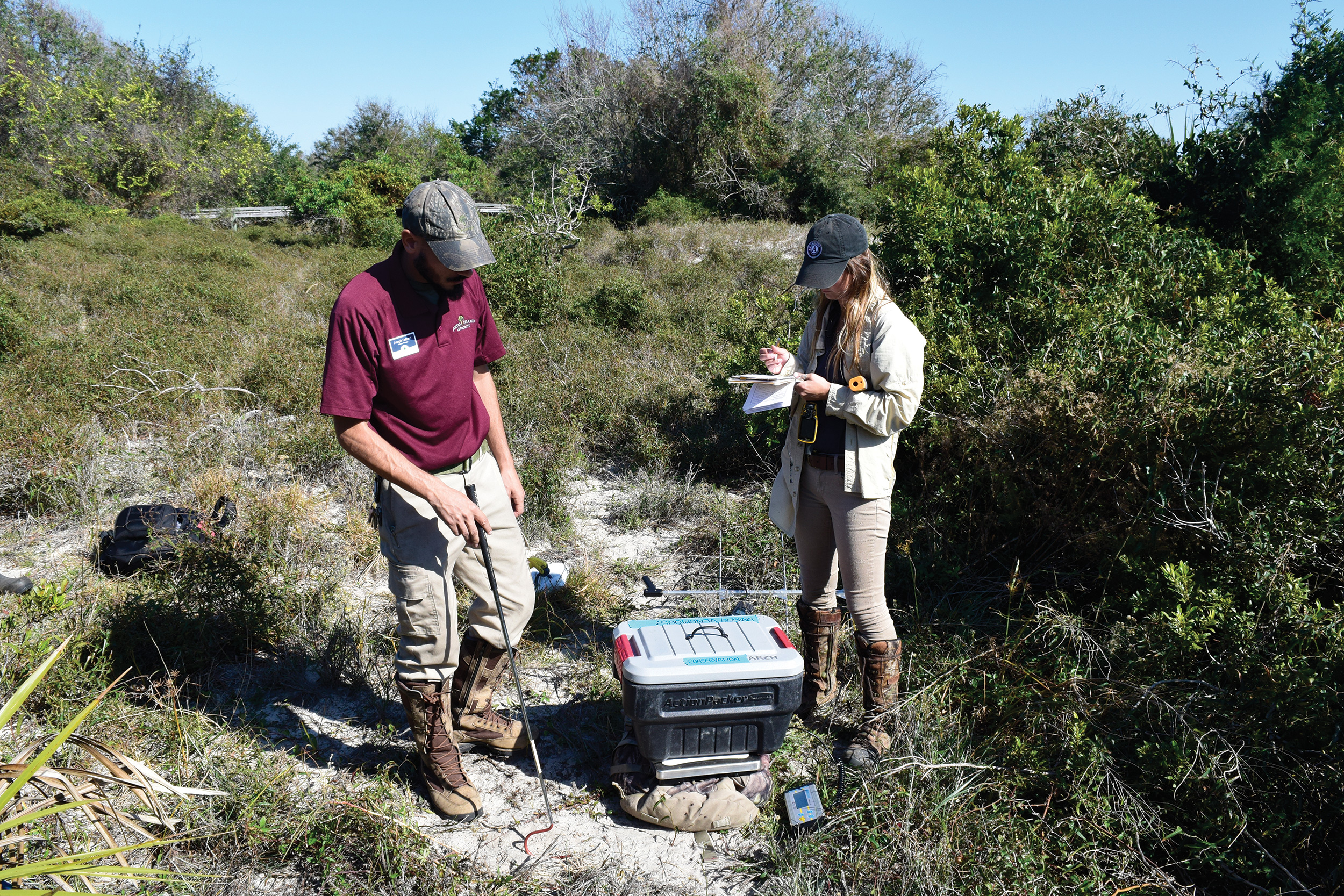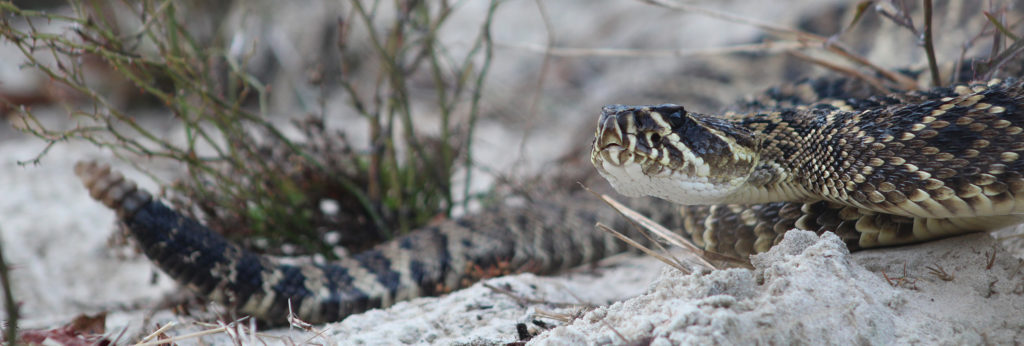Wildlife experts on Jekyll want to share the underappreciated awesomeness of eastern diamondback rattlers. But first they have to find them.
By Justin Heckert

I’d never gone looking for snakes before. And Marcy the rattlesnake was somewhere in the marsh on Jekyll Island. I was holding a long antenna, tuning into Marcy like an FM dial. She spoke to us, in a beep, through an R-1000 receiver attached to the antenna. Roughly five feet long, Marcy had been surgically implanted with a transmitter the size of a AA battery.
The antenna, called a YAGI, had lots of prongs and looked like I’d pulled it out of 1950s science fiction. Joseph Colbert, the Jekyll Island Authority’s wildlife manager and master snake detector, said he was trying to track a rattlesnake once and an island resident saw the YAGI and asked, “Are you looking for aliens?”
Colbert, in a ball cap and Jekyll Island Authority polo shirt and cargo pants, had handed me the YAGI at the start of this adventure through the green saw palmettos. “You track Marcy,” he said.
Eastern diamondback rattlesnakes, or Crotalus adamanteus, are the largest pit vipers in North America. Once prominent in the longleaf pine forests of the Southeast, their presence has sharply dwindled along with that habitat. (Their status as federally endangered or threatened awaits review.) No one knows how many live on Jekyll, but they are key predators and help keep the island from becoming overrun by rabbits and rodents. They are not a threat to humans unless blatantly attacked; there has never been documentation of anyone getting bitten by one on Jekyll. Still, there are reasons to track them—to learn about their movements and where they live and how they reproduce, to try and keep them safe from us—and I was one of four people tramping through the brush on the southern end of the island looking for Marcy, the November sun drying the mud on our boots and the green blades cutting into our clothes.
Colbert moved fast—he’d tracked thirty-four rattlesnakes here in six years. Also in our crew were Yank Moore, conservation land manager for the Jekyll Island Authority, camera around his neck, and Cailin Lutz, an AmeriCorps volunteer with backpack and clipboard, who referred to diamondback rattlers as “snugglebears.” It bothered her that the snakes had a stigma, that people generally were terrified of them, and often when she found snakes deceased, they hadn’t died of natural causes. “People get scared and kill them and feel like they’re doing a civic duty, like they’re protecting everyone,” says Colbert. “Something we’re trying to combat is that ideology.”
Marcy’s beeping faded or popped louder depending on where I pointed the antenna.
“This will be anticlimactic,” Colbert said, almost to reassure me. “We’re just going to walk up and she’s just going to sit there. But it’s therapeutic for me. Taking people out to see a rattlesnake for the first time, it’s amazing.”

Once there was a snake named Palehorse. He was kind of amazing himself, long and beautiful, found on the island in 2013 on the tenth anniversary of the invasion of Iraq, where Colbert had served as a Marine. “He was a good snake. He ate a lot, and he was over five feet long,” Colbert recalls. Palehorse had been the nickname of Colbert’s company unit’s call sign—1st Battalion, 2nd Marine Regiment, Charlie Company.
There was Cruella, named because she rattled defiantly at Colbert the first few times he tracked her. She had a scar on her head from where a human had likely attacked her. And there was Elvira, a snake he found on Halloween.
Presently on Colbert’s radar were Athena and Hannibal. Damia and Loverboy. Stallone, Rhea, and Romeo, named because he was found “hugging” another snake during mating season. There was Marcy, of course, and Eloise, who had been missing for a while. Maybe her transmitter had gone out. Nine snakes currently had transmitters inside them, surgically implanted by veterinarian Terry Norton at the Georgia Sea Turtle Center. It’s a delicate procedure: First the snakes are placed in long, clear plastic tubes to keep them from turning around, and then—much like a human going under the knife—they are anesthetized and intubated. No one touches the animal until the anesthesia takes effect. The transmitters are harmless and can last up to two years.
“We typically want to have them at least a year so we can monitor them through hibernation season, foraging season, breeding season, and then it’s back into hibernation season,” says Colbert.
Before our adventure, Colbert sat at his computer in his office and showed me nearly 4,000 purple dots on a map of the island. The dots looked like a work of stipple art, and each represented a single location for one of the thirty-four snakes that had been tracked since 2011.
“Tracking them, we can find out how closely they come to people,” he said. “And do they go in areas that pose a risk to the snake? What can we do to prevent or mitigate that?”
As the map demonstrated, visitors to Jekyll don’t need to worry about tripping over a rattler. The snakes avoid yards, businesses, golf courses, and open areas where grass is cut. They rarely cross roads. “They like to be in more densely vegetated areas that provide cover that makes them feel safe and secure, where they won’t be stepped on by people or large animals like deer,” says Colbert.
“Another reason we’re doing this research: they’re a top predator. And a top predator is an indicator of a healthy ecosystem,” he says. “If you take a diamondback out of the dunes, rabbits might just multiply like you wouldn’t believe and tear up plants.” It’s a phenomenon known as “trophic cascade,” where the fate of a top predator causes a chain reaction in the larger habitat. When wolves disappeared from Yellowstone park, so did aspen tree saplings, a favorite snack of elk, moose, and deer. When the wolves returned, so did the aspens.
Colbert had first seen a rattlesnake in boot camp on Parris Island, South Carolina, and had been fascinated. In 2009, while studying biology at the University of South Carolina, he interned in an ecology lab and ended up back on Parris Island, surveying eastern diamondback rattlesnakes. Now on Jekyll, he wanted to tell the stories of local snake species, to take them in public and let people hold them, talk about their names. If a snake needed to live in captivity for health reasons, it might serve as one of Jekyll’s educational ambassadors at local events such as the Shrimp and Grits Festival or Whiskey, Wine & Wildlife. This helped combat ophidiophobia—and provided a safe way for people to satisfy an innate curiosity.
In the vast majority of venomous snakebite incidents in the U.S., it’s the humans taking the initiative: People trying to kill snakes. Inexperienced pet owners mishandling their snakes. “A lot of males age eighteen to thirty-five get drunk and want to touch a snake,” Colbert said, sighing. “You have to campaign for a diamondback bite.”
“They’re not going to bite you,” Lutz said. “Just leave them be.”

We found Hannibal in the forest by raccoon tracks, under live oaks draped with Spanish moss. The beeping receiver led us right to his transmitter. The night before, in the cold, he must’ve curled up under the ground in an old dune swale, and we could barely see him in the dark of a hole. Hannibal had been tracked off and on since 2012 and was a snake the residents knew and cared about. “People ask me when I come out of the dunes, having tracked him, ‘How is he doing? What did he do today?’ ” Lutz said. “People become attached to them.”
“It got cold last night and now it’s warm. He’s probably trying to defrost,” Moore said.
Lutz wrote down his location and temperature, which she took by pointing an orange temperature gun at him. He was in a hibernaculum, a place to safely rest.
Then we found Damia near the boardwalk, one hundred feet from the water. The colors of her body blended in with both the shadows and the sun. She was about five feet long, in a coil, motionless. Sort of gold-colored, the end of her tail lacking a diamond pattern, and dull. She was going through ecdysis, the process of shedding old skin.
Athena—well, we didn’t even need the antenna to find her. We walked right up to her, accidentally, by a wax myrtle; she crossed by our feet near a soccer field by the beach. A slithery thing, noiseless, not scary at all. Colbert took a pair of tongs with a hook on them, grabbed her quickly, and placed her in a cooler. He weighed her. Then he took the lid off the cooler and her small head popped out, staring. He lifted her out and gently set her on the ground, and she retreated into the woods without looking away from us.
“If someone encounters a snake that is sitting still, they should simply give it some space and walk widely around,” Colbert said. “If it is moving when they encounter it, they should let it pass, then proceed once it has gone. [The snakes] aren’t aggressive, and they don’t want to risk dying, so they will often freeze and hope people don’t notice them.” Never corner a snake or approach it closely for a photo op; only when harassed will a snake make aggressive gestures.
The afternoon was filled with bright sun and the beeping of the receiver. We walked over sandspur grass and into deep mud. Passed old trees that loomed over the land. Tasted sea pickle, a small, bright-green plant on the marsh. Then we were in the marsh hammock, getting closer and closer to Marcy. She was elusive, for a while. It would be wrong to say that I found her. Colbert helped me point the antenna.
She was under palm fronds, underground—cold, too, from the night before. I was able to get right up to where she was and the beeping was loud and clear. It was kind of anticlimactic, like he said it would be, and it was also kind of amazing.


